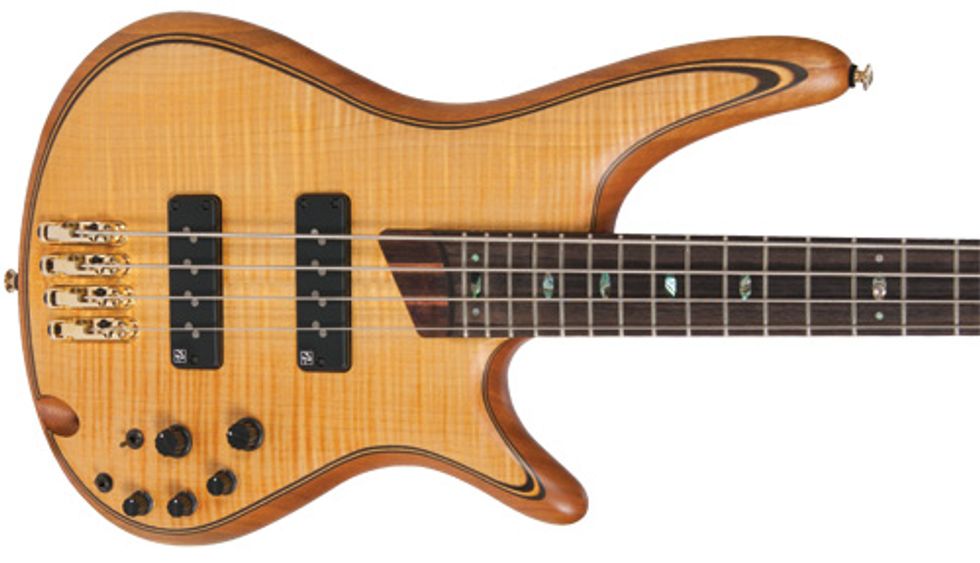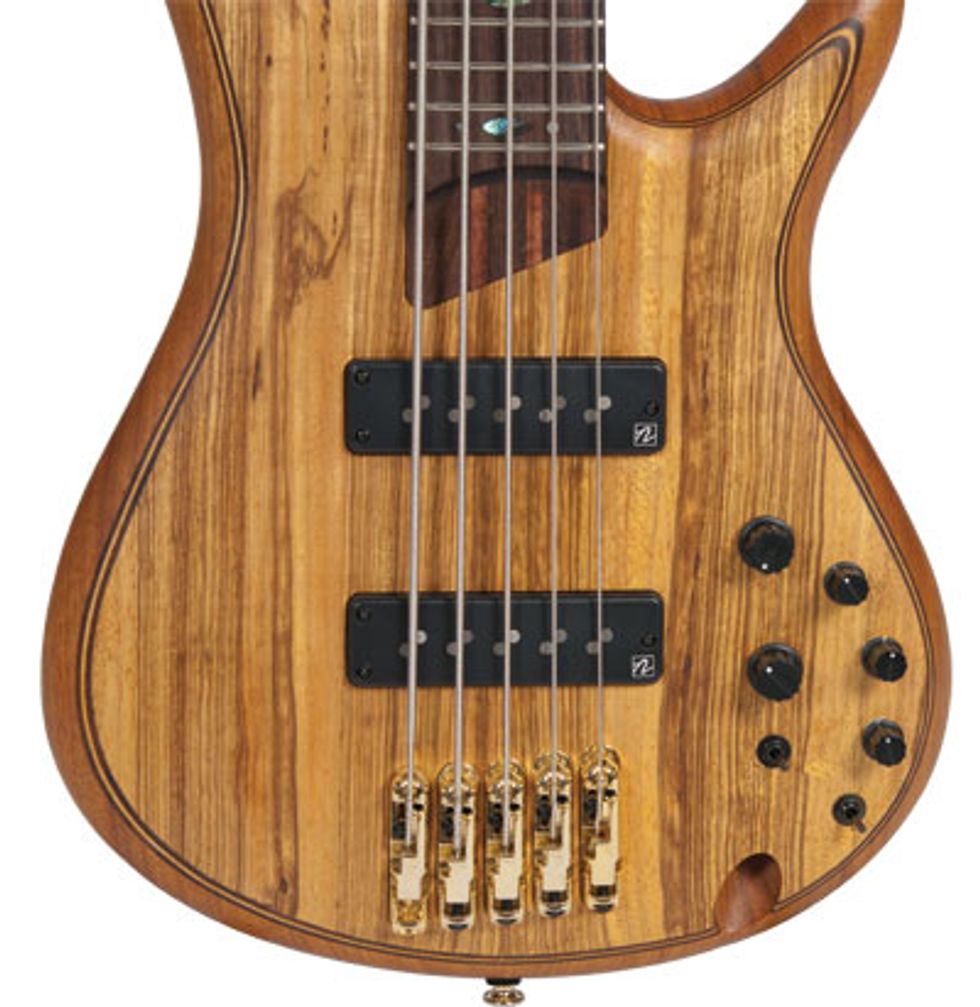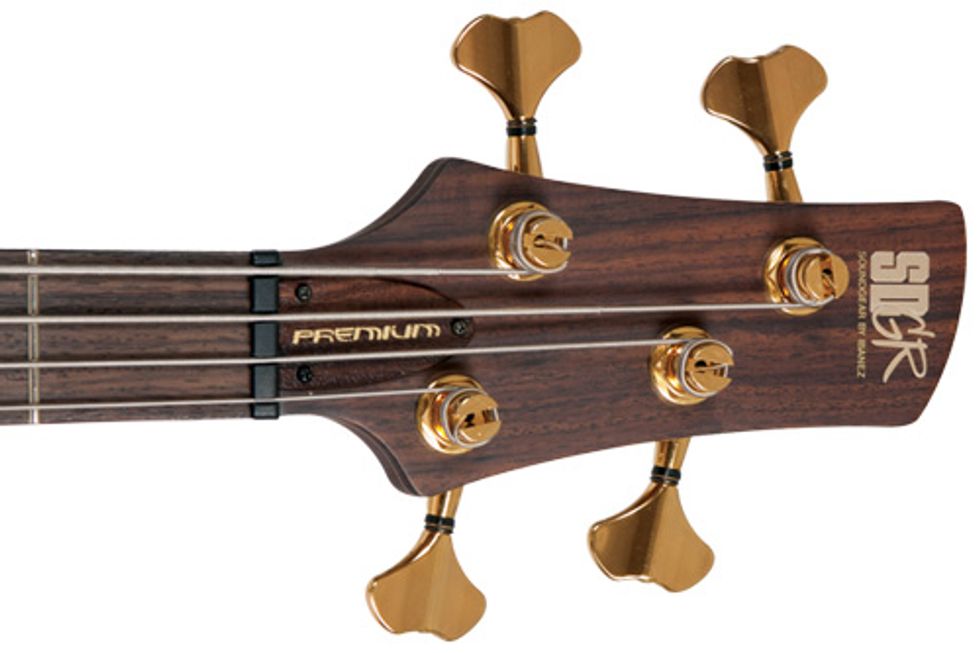
This pair of new Ibanez basses feature high-end appointments tasteful finishes for both 4- and 5-stringers.
| Download Example 1 SR1205 - Pickup balance even, Tone controls set at detents. | |
| Download Example 2 SR1400 - Pickup balance even, Tone controls set at detents. | |
| Clips recorded direct into GarageBand through an Axeport Pro interface. | |
Even with these appointments, these two basses will not break the bank. Each comes in at just a little over a grand, which is a lot of instrument per dollar.

What’s in Common?
Along with the slim necks and sleek bodies, both basses share several hardware components. Both have easy-turning Gotoh tuners and Ibanez’s Mono-Rail bridge that utilizes separate units for each string. This design really does a great job of transferring string vibrations and takes just one screw to adjust each unit’s string height—so no worrying about having less-than-even saddle to plate contact. The pickups on both basses are Nordstrand Big Singles, which Nordstrand describes as providing “huge, full, loud, aggressive single-coil tone.” Or, to use a well-worn comparison, a “Jazz bass on steroids.” The key to this pickup design is turning traditional Jazz bass pole pieces at a 45-degree angle, allowing a wider pickup with more wire.
To check out the difference, I pulled out a Jazz bass without steroids—my stock 1974 model—and played all three basses with a flat EQ and both pickups set to the same volume level. Certainly, both Ibanez basses were a little louder than my passive Jazz, but not radically so. Likewise, both Ibanez basses did have somewhat more punch and clarity than the Jazz. Despite having the same pickup design, I was surprised to find that the 5-string 1205E had a noticeably deeper, fatter tone than the 4-string, probably from differences between the body woods (more on that soon).

The polepieces of basses' Nordstrand Big Singles are turned at a 45-degree angle. The pickups were slightly louder, with more punch and clarity, than a vintage J-bass pickup.
Another common trait with these two basses is their electronics design, which includes three bands of EQ, a switchable midrange center frequency, and an EQ defeat switch. All three bands of EQ are cut/boost, so both basses are able to cover a wide range of sound. Also onboard are controls for pickup blend and master volume. The jack on both basses is set into a neat scoop on the front of the body to avoid the usual 90-degree angle between body and plug—an extra bit of security when you accidentally step on the cord and yank the plug.
One thing I noticed on both basses was that the control cavity was attached with screws into threaded inserts. This is an important touch to avoid stripping the body wood after a bunch of battery changes, but that problem could also be avoided by going with a separate battery box. I always worry that a wired battery clip will eventually need replacing or repairing. Inside the control cavity, I found more wire than I’d normally like to see and a preamp floating under a piece of foam. I always thought leaving extra wire beyond what’s needed for hooking up the pickups acts like a noise antenna. Combining that extra wire with conductive paint shielding (I prefer copper foil) and single coil pickups usually equals a recipe for some extra noise. With the pickups set at even levels, both basses were relatively quiet. But I usually like to favor one of the two pickups in a single-coil bass setup since it produces a touch more punch and clarity. Unless I held these basses at the correct angle to my amp, the noise was noticeable, although not much more so than my Jazz bass.

Each bass has the option of ovangkol (pictured) or flame maple (pictured on previous page) top wood.
Both models were crafted in the Ibanez premium factory in Jawa Timur, Indonesia. In terms of build, both basses have multi-laminated bodies and necks, and titanium reinforcing rods inside the neck, which usually enhances sustain and stabilizes intonation. Each has a natural satin finish, a bolt-on neck that blends into the body top (looking a bit like a neck-through design), and diamond-shaped abalone position marker inlays up and down the neck. The tilt-back headstocks avoid the need for string trees, giving the headstock a nice, clean look.
In addition, both basses have the same wenge and bubinga neck sandwich, providing a sensuous feel through their satin finish. Another touch of visual class is the dark wood cap on the top of the headstock.
So How Do They Differ?
Mostly obviously, the 1205E has one more string, one more tuner, one more bridge unit, and one more pair of pickup pole pieces. But these two basses differ most noticeably from the woods they are built with—and the resulting difference in tone. While the 1400E weighed in at a dainty 7.5 pounds, the 1205E hefted a full pound more. The additional string and its accouterments certainly account for part of the weight difference, but I’d attribute more of that weight to their respective woods.
Although both axes have the same wenge/bubinga neck, the body of the 1400E is built from mahogany with a flame maple cap. This wood combination allows for the smooth, warm lows of mahogany plus a bit of that maple bite and brightness. In contrast, the 1205E uses ovangkol instead of flame maple cap. While flame maple (sometimes referred to as tiger maple) provides a flashy, high-class appearance, ovangkol possesses an earthier look and a more varied grain pattern. Tonally, I heard a darker, deeper, rounder tone out of the 1205E’s ovangkol compared with the 1400E’s maple. Each bass essentially sounded the way it looked.

The headstocks on both basses are tilted back, eliminating the need for a string tree.
The Verdict
Both the 1205E and the 1400E are beautifully crafted instruments with decidedly exotic looks. Ibanez makes both body wood combinations in four-string and five-string versions, so whether you’re after the snap of maple or the depth of ovangkol, you won’t need to forego your preferred string setup. Happily, the setup was good on both basses and the nuts were cut to the right depth on both of the review basses—although the top could have been taken down a bit on the four-string. The woodwork was neat and careful, and the satin finish was smoothly applied. The onboard EQ allows for plenty of tonal variation that can move either instrument into the other’s sonic territory.
If there was one thing I would change, it would be a switch to copper foil shielding and tidier wiring in the cavity—plus a separate battery box.
Buy if...
you’re after a sleek, light, modern-looking bass with flash and style and you like natural woods.
Skip if...
you’re a traditionalist in your basses and prefer simple design, minimal controls and a little heft.
Rating...
Street SR1205E $1099, SR1400 $1049 - Ibanez - ibanez.com |
